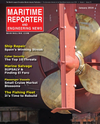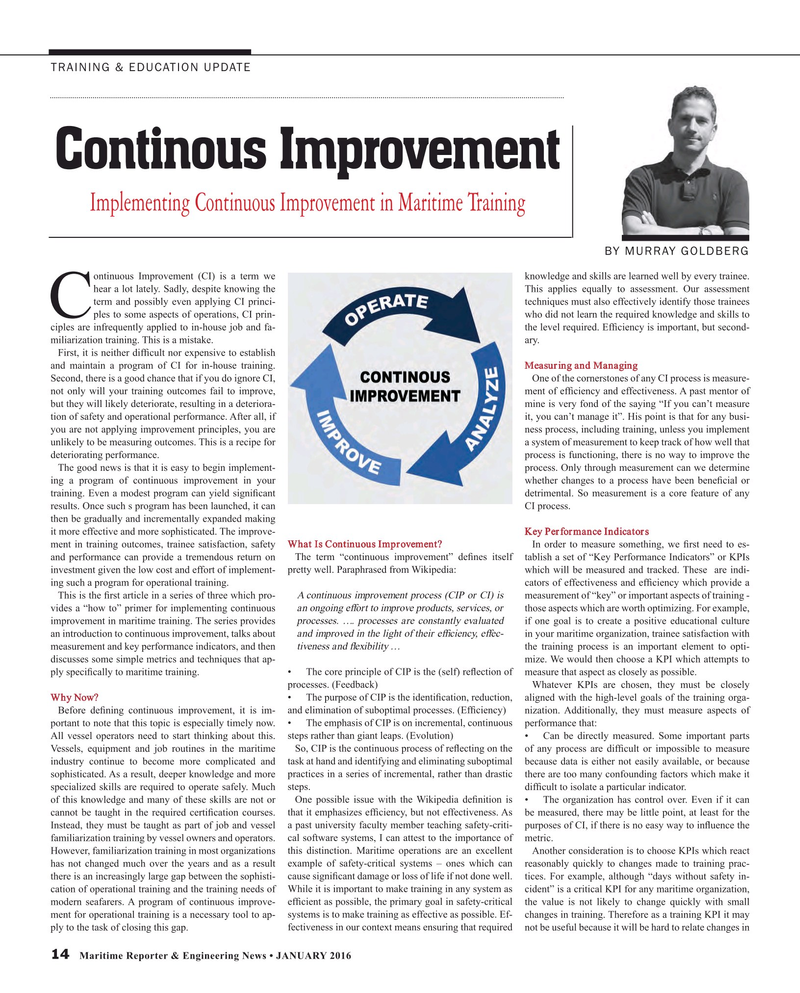
Page 14: of Maritime Reporter Magazine (January 2016)
Ship Repair & Conversion Edition
Read this page in Pdf, Flash or Html5 edition of January 2016 Maritime Reporter Magazine
TRAINING & EDUCATION UPDATE
Continous Improvement
Implementing Continuous Improvement in Maritime Training
BY MURRAY GOLDBERG ontinuous Improvement (CI) is a term we knowledge and skills are learned well by every trainee. hear a lot lately. Sadly, despite knowing the This applies equally to assessment. Our assessment term and possibly even applying CI princi- techniques must also effectively identify those trainees
Cples to some aspects of operations, CI prin- who did not learn the required knowledge and skills to ciples are infrequently applied to in-house job and fa- the level required. Ef? ciency is important, but second- miliarization training. This is a mistake. ary.
First, it is neither dif? cult nor expensive to establish and maintain a program of CI for in-house training. Measuring and Managing
Second, there is a good chance that if you do ignore CI, One of the cornerstones of any CI process is measure- not only will your training outcomes fail to improve, ment of ef? ciency and effectiveness. A past mentor of but they will likely deteriorate, resulting in a deteriora- mine is very fond of the saying “If you can’t measure tion of safety and operational performance. After all, if it, you can’t manage it”. His point is that for any busi- you are not applying improvement principles, you are ness process, including training, unless you implement unlikely to be measuring outcomes. This is a recipe for a system of measurement to keep track of how well that deteriorating performance. process is functioning, there is no way to improve the
The good news is that it is easy to begin implement- process. Only through measurement can we determine ing a program of continuous improvement in your whether changes to a process have been bene? cial or training. Even a modest program can yield signi? cant detrimental. So measurement is a core feature of any results. Once such s program has been launched, it can CI process.
then be gradually and incrementally expanded making it more effective and more sophisticated. The improve- Key Performance Indicators ment in training outcomes, trainee satisfaction, safety What Is Continuous Improvement? In order to measure something, we ? rst need to es- and performance can provide a tremendous return on The term “continuous improvement” de? nes itself tablish a set of “Key Performance Indicators” or KPIs investment given the low cost and effort of implement- pretty well. Paraphrased from Wikipedia: which will be measured and tracked. These are indi- ing such a program for operational training. cators of effectiveness and ef? ciency which provide a
This is the ? rst article in a series of three which pro- A continuous improvement process (CIP or CI) is measurement of “key” or important aspects of training - vides a “how to” primer for implementing continuous an ongoing effort to improve products, services, or those aspects which are worth optimizing. For example, improvement in maritime training. The series provides processes. …. processes are constantly evaluated if one goal is to create a positive educational culture an introduction to continuous improvement, talks about and improved in the light of their ef? ciency, effec- in your maritime organization, trainee satisfaction with measurement and key performance indicators, and then tiveness and ? exibility … the training process is an important element to opti- discusses some simple metrics and techniques that ap- mize. We would then choose a KPI which attempts to ply speci? cally to maritime training. • The core principle of CIP is the (self) re? ection of measure that aspect as closely as possible. processes. (Feedback) Whatever KPIs are chosen, they must be closely
Why Now? • The purpose of CIP is the identi? cation, reduction, aligned with the high-level goals of the training orga-
Before de? ning continuous improvement, it is im- and elimination of suboptimal processes. (Ef? ciency) nization. Additionally, they must measure aspects of portant to note that this topic is especially timely now. • The emphasis of CIP is on incremental, continuous performance that:
All vessel operators need to start thinking about this. steps rather than giant leaps. (Evolution) • Can be directly measured. Some important parts
Vessels, equipment and job routines in the maritime So, CIP is the continuous process of re? ecting on the of any process are dif? cult or impossible to measure industry continue to become more complicated and task at hand and identifying and eliminating suboptimal because data is either not easily available, or because sophisticated. As a result, deeper knowledge and more practices in a series of incremental, rather than drastic there are too many confounding factors which make it specialized skills are required to operate safely. Much steps. dif? cult to isolate a particular indicator.
of this knowledge and many of these skills are not or One possible issue with the Wikipedia de? nition is • The organization has control over. Even if it can cannot be taught in the required certi? cation courses. that it emphasizes ef? ciency, but not effectiveness. As be measured, there may be little point, at least for the
Instead, they must be taught as part of job and vessel a past university faculty member teaching safety-criti- purposes of CI, if there is no easy way to in? uence the familiarization training by vessel owners and operators. cal software systems, I can attest to the importance of metric.
However, familiarization training in most organizations this distinction. Maritime operations are an excellent Another consideration is to choose KPIs which react has not changed much over the years and as a result example of safety-critical systems – ones which can reasonably quickly to changes made to training prac- there is an increasingly large gap between the sophisti- cause signi? cant damage or loss of life if not done well. tices. For example, although “days without safety in- cation of operational training and the training needs of While it is important to make training in any system as cident” is a critical KPI for any maritime organization, modern seafarers. A program of continuous improve- ef? cient as possible, the primary goal in safety-critical the value is not likely to change quickly with small ment for operational training is a necessary tool to ap- systems is to make training as effective as possible. Ef- changes in training. Therefore as a training KPI it may ply to the task of closing this gap. fectiveness in our context means ensuring that required not be useful because it will be hard to relate changes in 14 Maritime Reporter & Engineering News • JANUARY 2016
MR #1 (10-17).indd 14 1/6/2016 12:25:13 PM

 13
13

 15
15
